To ensure resin-bound gravel remains stable on sloped surfaces, begin by accurately assessing the slope gradient with tools such as laser levels. Prepare the surface thoroughly, ensuring the sub-base is solid. Choose aggregates that enhance traction, preferably angular stones sized between 2-5mm. Implement drainage systems to effectively manage water runoff, and install edge restraints to prevent movement. It’s crucial to maintain proper resin-to-aggregate ratios and use thicker layers for added durability. These measures will help optimise your installation for lasting performance.
Key Takeaways
- Assess the slope gradient, ensuring it remains within the recommended 1-2% for proper drainage and stability.
- Use a solid sub-base and ensure proper compaction to strengthen the structure and reduce erosion risk on slopes.
- Choose an appropriate aggregate blend, particularly angular stones sized between 2-5mm, for better traction on inclined surfaces.
- Install edge restraints and drainage systems to prevent gravel displacement and effectively manage water runoff.
- Keep an eye on resin consistency during installation, making sure it’s mixed and applied correctly to boost adhesion and durability on slopes.
Understanding Slope Gradient and Its Impact on Installation
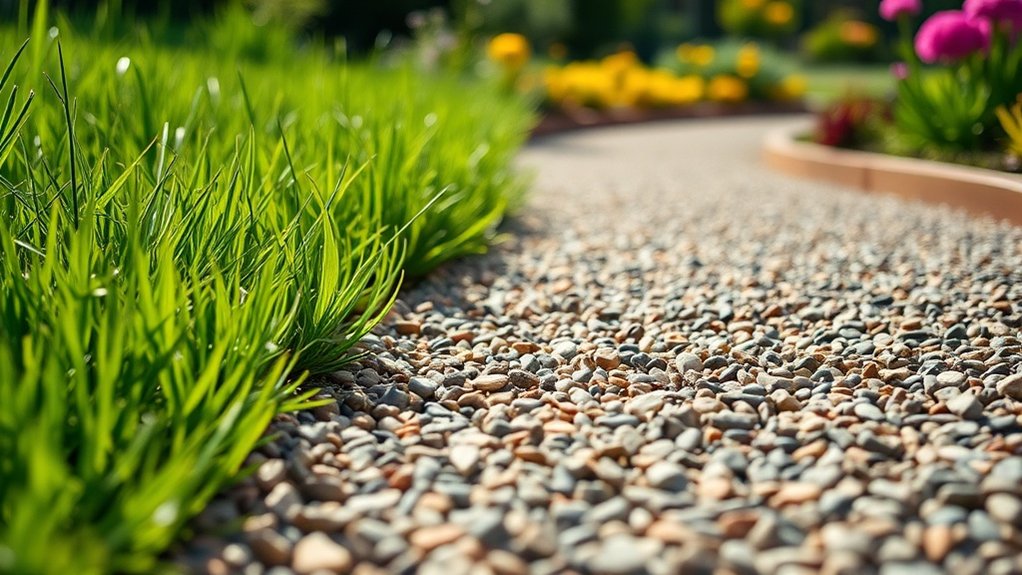
When installing resin-bound gravel on sloped surfaces, understanding the slope gradient is crucial as it affects the installation process. The gradient measures how much a surface rises over a certain distance, influencing water flow and material distribution. Steeper slopes (over 10%) can pose challenges; the resin may flow downhill before it sets, resulting in uneven coverage. To ensure effective drainage, a minimum slope of 1-2% is advisable, as this helps direct water flow and prevents pooling at the bottom of the slope. Proper installation is key to ensuring that resin surfaces can withstand the forces of gravity and water flow. Therefore, accurately assessing the slope gradient is vital for creating a stable, durable, and visually appealing resin-bound surface on sloped areas. Additionally, the permeability of resin driveways allows for efficient water drainage, further enhancing stability on sloped surfaces. Furthermore, using angular stones can greatly improve grip properties, ultimately contributing to a more secure installation.
Importance of Proper Surface Preparation
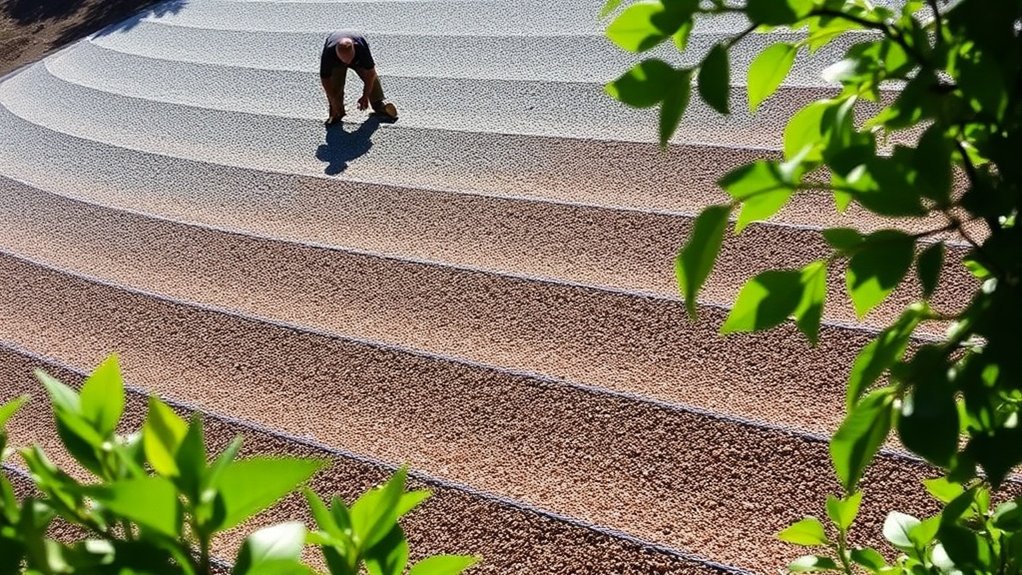
Proper surface preparation is essential for ensuring the stability of resin-bound gravel on sloped surfaces.
First, assess the slope gradient and make sure the base is stable, addressing any issues beforehand.
For example, if the ground is soft or uneven, it’s crucial to rectify that before proceeding. Effective compaction techniques will improve the structural integrity and drainage of the sub-base, helping to prevent any future movement. Additionally, proper preparation is crucial for the mixture to set correctly, which further contributes to the stability of the resin-bound gravel. A well-prepared sub-base enhances effective drainage, ensuring that water flows naturally and minimizes the risk of erosion.
Assessing Slope Gradient
Assessing slope gradient is crucial for effective surface preparation in resin-bound gravel applications. Accurate evaluation ensures you use the proper preparation techniques, minimising the risk of future instability.
- Use slope measurement tools such as laser levels and inclinometers for precise readings on site.
- Implement gradient assessment tools, like GIS software, to create slope maps and calculate gradients effectively. This will help highlight areas of slope analysis that may require special attention. Additionally, ensuring proper surface preparation is vital for achieving optimal adhesion of the resin to the underlying concrete.
- Categorise slopes to inform your choices regarding installation methods.
Ensuring Base Stability
Achieving a stable base is crucial for any successful resin-bound gravel installation. Start by checking the soil conditions to ensure the underlying ground is stable and not prone to shifting.
Choose the right base materials; options like concrete or open-graded tarmacadam are ideal as they offer strength and good drainage. Pay attention to drainage to avoid water accumulation, which can compromise stability.
Compact the subgrade properly to prevent settling and ensure it can support the intended load. Consider using permeable bases to meet SuDS regulations and promote water flow.
Regularly check the base layer’s thickness and level to maintain a solid foundation that can withstand the weight of resin-bound gravel.
Compaction Techniques Applied
Compaction techniques are crucial for ensuring the stability of resin-bound gravel installations on slopes. Effective mechanical compaction improves surface uniformity and helps prevent future issues.
- Use mechanical plate compactors to consolidate the base material effectively.
- Compact in thin layers to achieve maximum density and minimise uneven areas.
- Regularly check surface levels to maintain the correct gradient and avoid water pooling.
Choosing the Right Aggregate Blend for Slip Resistance
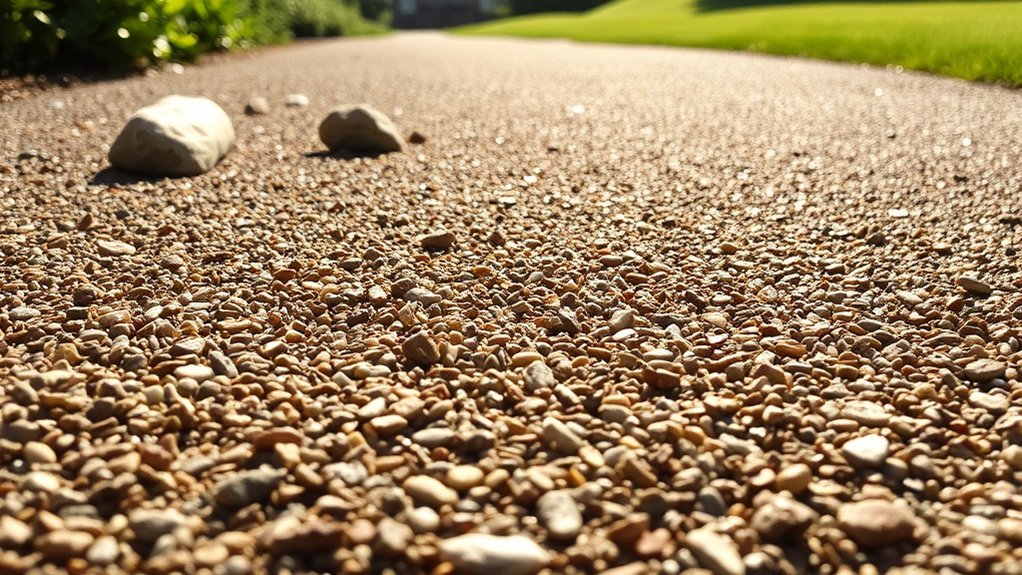
When choosing an aggregate blend for slip resistance, pay attention to both size and type.
Larger aggregates generally improve traction, while mixing different textures can enhance surface stability.
For instance, using a combination of coarse and fine aggregates can provide a safer walking surface on sloped areas.
This thoughtful selection helps ensure a secure environment for pedestrians.
Aggregate Size Selection
Choosing the right aggregate blend is crucial for ensuring optimal slip resistance on sloped surfaces. Here are key factors to consider:
- Size Range: Aim for aggregates between 2-5mm for improved grip.
- Shape: Select angular stones rather than smooth ones to enhance traction.
- Drainage: Ensure aggregates are permeable to allow effective water drainage.
Durability and compatibility with the resin mixture are vital for a long-lasting surface.
Angular aggregates not only boost slip resistance but also create a textured finish.
The right blend enhances stability and reduces erosion, ensuring safety and longevity on slopes.
Make informed decisions to maintain a durable surface that complies with UK standards.
Blending for Optimal Traction
To achieve optimal traction on sloped surfaces, it’s crucial to select the right aggregate mix. This choice impacts both safety and durability. Focus on using angular aggregates, as they enhance interlock and slip resistance. For instance, mixtures containing natural stone and crushed glass, like GRIPDUST, can boost traction without compromising on aesthetics.
| Aggregate Type | Traction Factor | Best Use |
|---|---|---|
| Angular | High | Sloped surfaces |
| Rounded | Low | Flat surfaces |
| Mixture (Glass/Stone) | Medium | Versatile uses |
A custom blend that suits your specific site conditions will ensure consistent slip resistance. It’s also important to maintain a uniform particle distribution to avoid slippery patches.
Techniques for Ensuring Adhesion and Stability
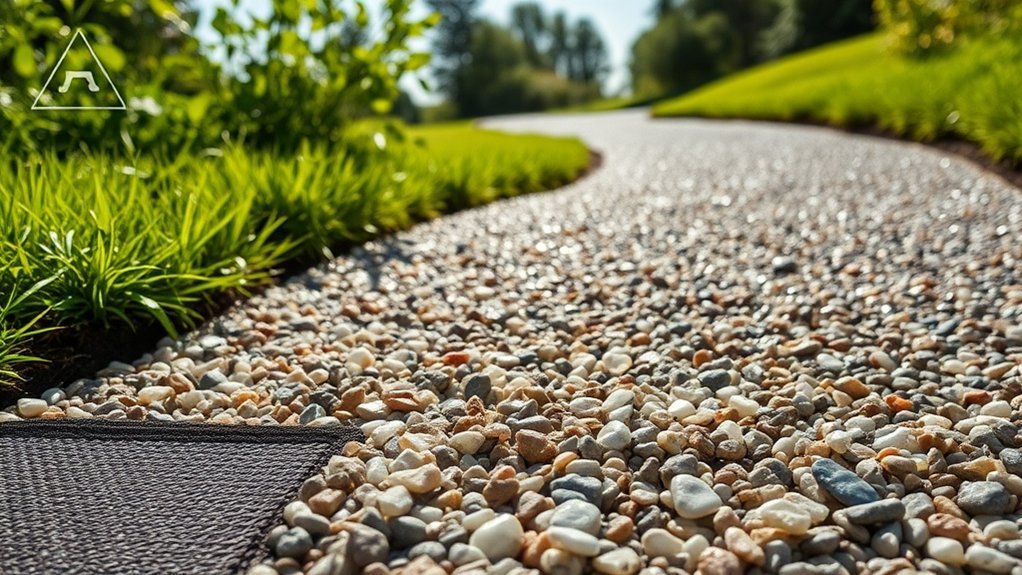
Ensuring adhesion and stability in resin-bound gravel applications on sloped surfaces requires careful base preparation and material selection. Here are the key factors to consider:
- Check the existing surface for stability and cleanliness.
- Opt for higher-viscosity resins to manage flow and improve bonding.
- Add grip additives to enhance traction and prevent slippage.
It’s crucial to monitor resin consistency and environmental conditions, such as temperature and humidity, as these can significantly affect curing and adhesion.
Properly priming the base and maintaining the right resin-to-aggregate ratio will boost durability and strength.
Enhancing Water Drainage to Prevent Erosion
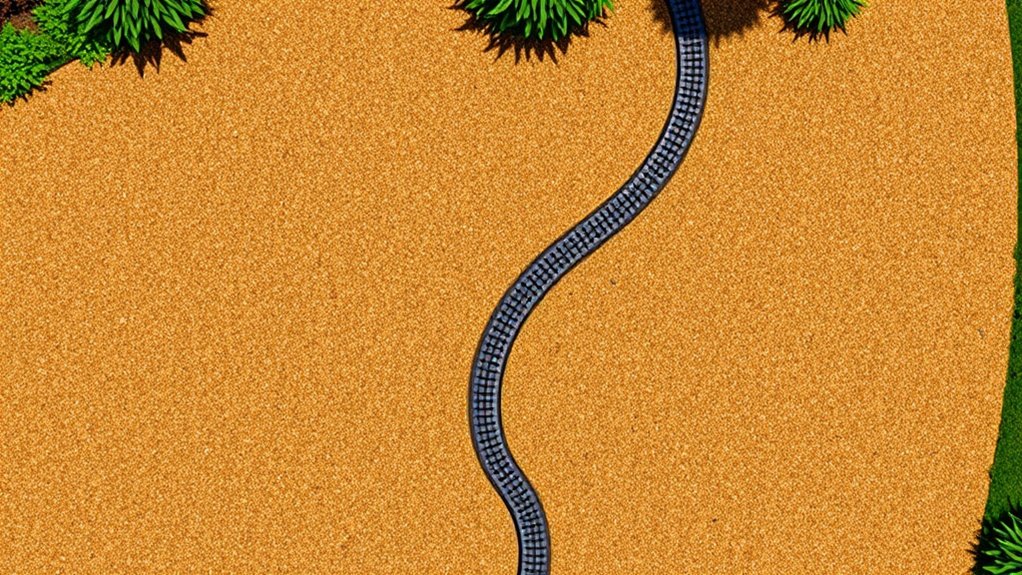
Effective drainage is crucial for preventing erosion on sloped surfaces and enhancing the stability of resin-bound gravel installations.
Start with a permeable sub-base, using materials like open grade tarmacadam or permeable concrete to allow for proper water flow. Ensure your slope is graded at 1-2% to direct runoff efficiently.
Incorporate drainage solutions such as perimeter drains or French drains to manage excess water and reduce accumulation at weak points.
Additionally, use edge restraints to keep the gravel in place and prevent displacement from water runoff.
The Role of Thickness in Durability on Steeper Slopes
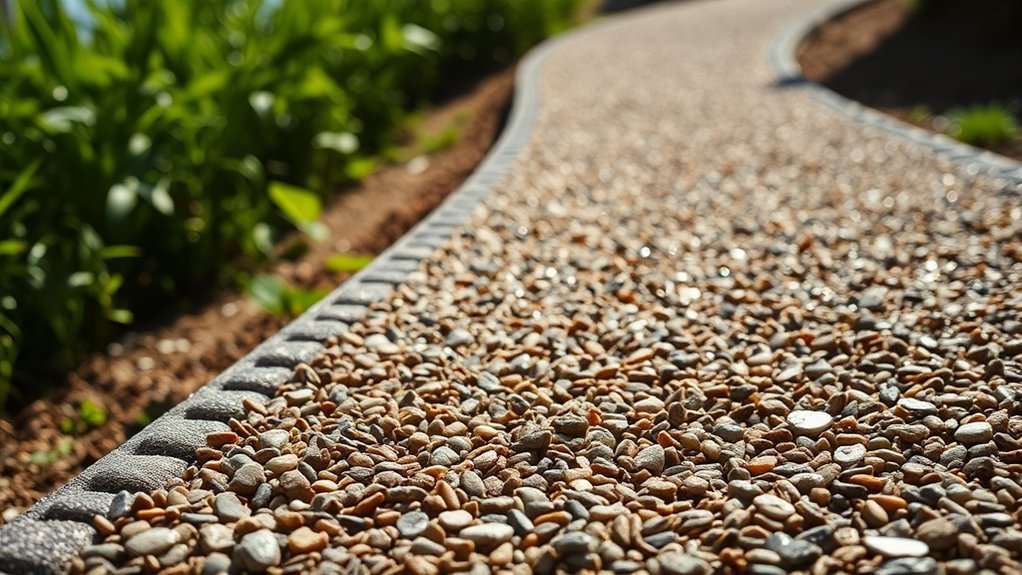
As the gradient of a slope increases, the thickness of resin-bound gravel installations becomes crucial for durability. A minimum depth of 18mm is essential to ensure long-lasting performance. The thickness should be at least three times the largest aggregate size, which helps maintain the integrity of the resin layer.
On slopes steeper than 10%, achieving a uniform resin thickness is vital to prevent weak spots that could cause damage. Choosing a less porous base material can also help prevent material displacement.
Ultimately, a properly installed and adequately thick resin layer improves resistance to both traffic and environmental factors, ensuring durability and longevity.
Specialized Installation Methods for Uneven Gradients
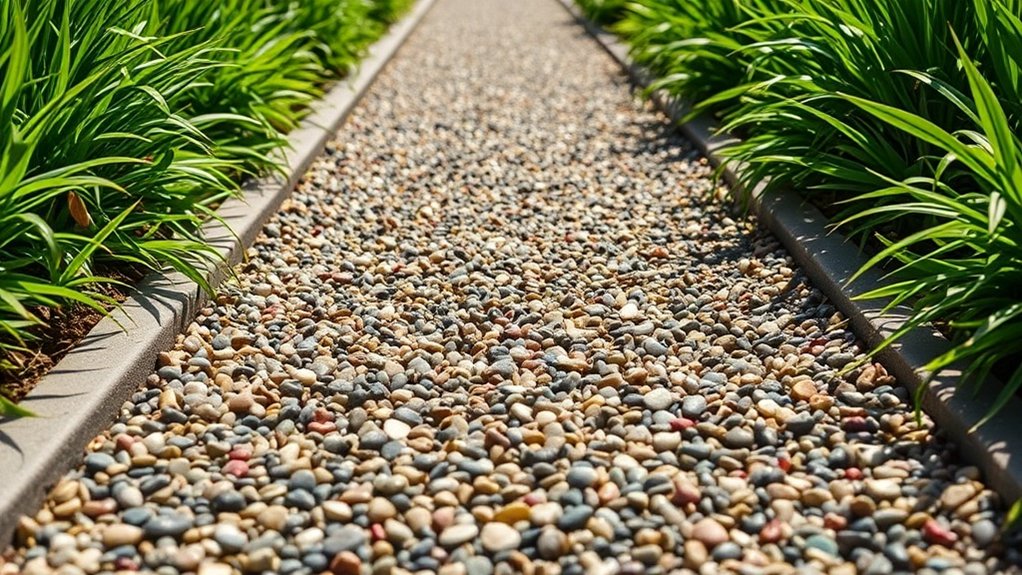
To successfully install resin-bound gravel on uneven gradients, it’s important to use specialised techniques that tackle the unique challenges of sloped surfaces. Here’s a straightforward overview of effective methods:
| Technique | Purpose | Key Considerations |
|---|---|---|
| Stable Sub-base | Prevent substrate shifting | Ensure aggregates are well-compacted |
| Geotextile Membranes | Stabilise materials on steep slopes | Minimise movement of materials |
| Firm Edges | Contain the gravel | Peg edges slightly higher than the surface depth |
| Drainage Integration | Manage water runoff | Create channels or gaps beneath the edges |
These techniques will help ensure a durable and stable installation on gradients, making your resin-bound gravel last longer and perform better.
Long-Term Performance and Maintenance Considerations
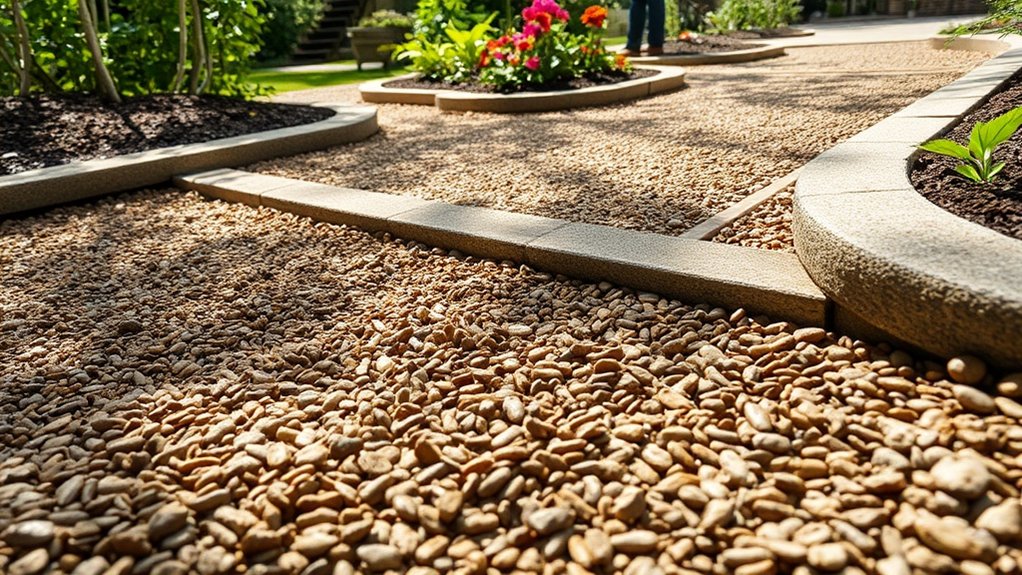
To ensure the long-term performance of resin-bound gravel on slopes, regular cleaning and periodic resealing are crucial.
Routine sweeping and gentle washing help maintain proper drainage and keep the surface intact.
Resealing every few years protects against UV damage and moisture infiltration.
Periodic Cleaning Practices
Periodic cleaning is crucial for keeping resin-bound gravel surfaces looking good and performing well over time.
Here are some straightforward practices to follow:
- Regularly sweep the surface to clear away debris and maintain permeability.
- Use gentle methods, such as a hose or soft brush, to avoid dislodging the gravel.
- Check drainage systems each month to stop water from pooling.
Resealing for Longevity
Maintaining the appearance and durability of resin-bound gravel surfaces requires more than just regular cleaning; resealing is crucial for longevity. It’s recommended to apply UV-stable sealants every five to eight years, or more frequently for driveways, depending on local conditions. Proper resealing techniques help prevent UV damage and ensure the surface remains permeable.
| Aspect | Details |
|---|---|
| Resealing Frequency | Every 2-8 years, depending on the environment |
| Sealant Types | UV-stable, resin-compatible for optimal durability |
| Application Best Practices | Ensure a clean, dry surface; adhere to manufacturer guidelines |
Safety Features of Resin-Bound Surfaces on Inclines
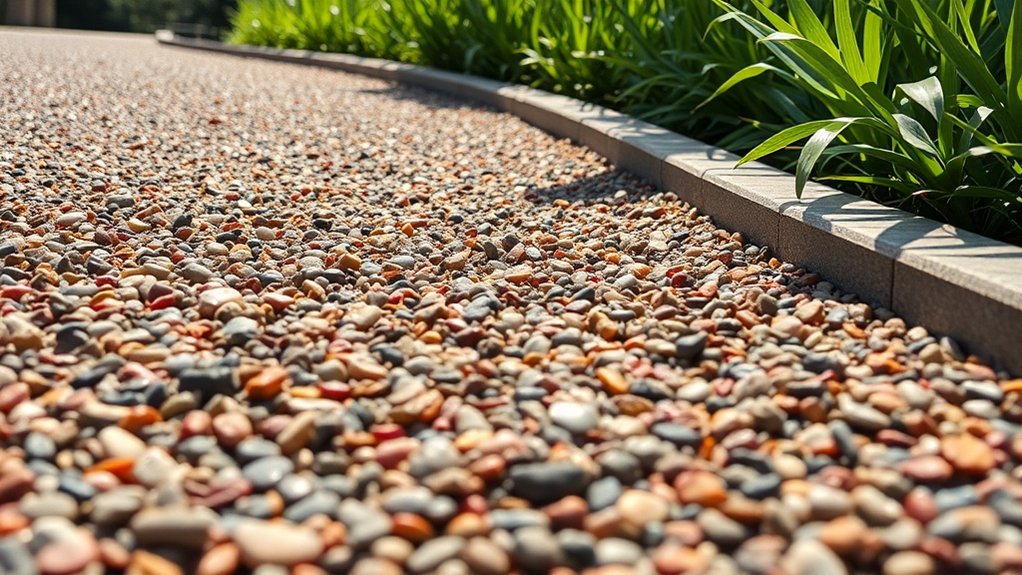
- Seamless and durable, resin-bound surfaces reduce the chance of skidding.
- Their permeable design prevents water from pooling, ensuring stability.
- These surfaces withstand freeze-thaw cycles, making them suitable for colder climates.
Resin-bound gravel offers a reliable surface for vehicles and enhances pedestrian safety.
With excellent traction and durability, it’s an ideal choice for inclines, providing reassurance throughout the year.
Aesthetic Options and Customization for Sloped Areas
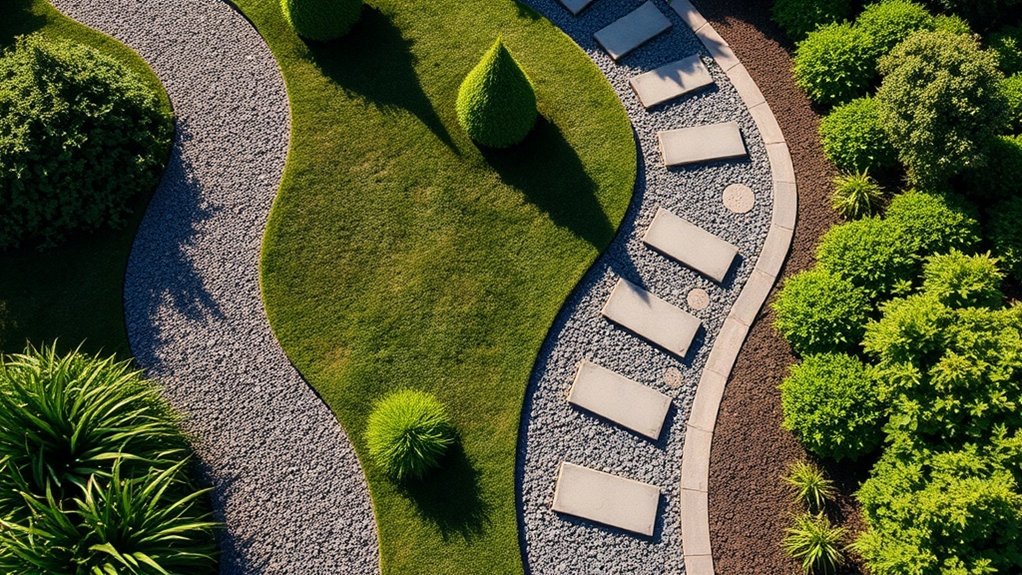
Resin-bound surfaces aren’t only safe and stable on slopes, but they also offer impressive aesthetic options and customisation.
You can select from a wide range of colours and aggregate types, allowing you to tailor the look to match your architectural style. By blending different aggregates, you can achieve unique textures and finishes that reflect your personal taste.
Adding geometric patterns or custom logos can enhance the visual appeal while keeping a seamless look, promoting a cohesive design.
Furthermore, incorporating landscaping features like raised planters or lighting can significantly boost the overall aesthetic.
With UV-stable resin and various surface finishes, your designs will stay vibrant and functional, ensuring that beauty and safety go hand in hand on your sloped surfaces.
Frequently Asked Questions
How Does Weather Affect the Installation Process of Resin-Bound Gravel?
Weather significantly influences the installation of resin-bound gravel. For instance, high temperatures can speed up curing, while cold weather may slow it down. Likewise, moisture—like rain or dampness—can compromise adhesion, leading to a weaker surface. It’s crucial to ensure dry conditions and optimal temperatures for a strong, long-lasting finish. Always check the forecast before starting your project to avoid any hiccups.
What Tools Are Needed for Installing Resin-Bound Gravel on Slopes?
To install resin-bound gravel on slopes, you’ll need a few essential tools. Start with a drill fitted with a paddle mixer for mixing the resin and aggregate. For surface preparation, a universal primer is necessary to ensure proper adhesion. When it comes to application, a resin trowel is ideal for achieving an even finish. Keep it simple and ensure you have these tools ready for a smooth installation process.
Can Resin-Bound Gravel Be Repaired if Damaged?
Yes, resin-bound gravel can be repaired effectively. To do this, start with a thorough clean to remove any dirt or debris. Then, mix the appropriate materials according to the manufacturer’s instructions and apply them carefully. Regular inspections and maintenance can help keep your repairs looking good and lasting longer. For example, if you notice any cracks or discolouration, it’s best to address them promptly to prevent further damage.
How Long Does the Installation Process Take for Sloped Areas?
The installation process for sloped areas typically takes around 2 to 3 days. Factors like the gradient and weather conditions can influence this timeframe, so careful planning is essential for a successful outcome. Think of it like assembling a jigsaw puzzle—each piece must fit together perfectly to achieve the best results.
What Are the Environmental Impacts of Resin-Bound Gravel Installations?
Resin-bound gravel installations are an environmentally friendly choice. They provide excellent drainage, which helps replenish groundwater and reduces surface runoff. Additionally, these surfaces filter pollutants, contributing to cleaner water. Their durability and low maintenance requirements mean they have a lower environmental impact compared to traditional materials. For example, unlike concrete, resin-bound gravel allows rainwater to soak through, making it a sustainable option for driveways and pathways.
Conclusion
To ensure the stability of resin-bound gravel on sloped surfaces, it’s essential to follow key techniques. Concerns about erosion and shifting can be addressed by preparing the surface properly and implementing effective drainage solutions. Picture a well-finished slope that not only looks appealing but also remains safe and functional for years. With careful planning and execution, you can create a durable and attractive landscape that endures over time.
